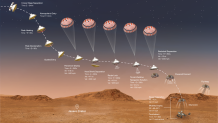What to Know
- Built in Southern California, NASA's Mars rover called Perseverance is due to touch down Thursday on the Red Planet.
- The landing after nearly seven months of space travel is scheduled for 12:55 p.m. California time.
- The process includes a series of high-stakes maneuvers and what the mission crew refers to as "seven minutes of terror."
A series of hold-your-breath moments Thursday will determine the success or failure of NASA’s Perseverance mission when the agency attempts to land its fifth rover on Mars.
Updates: Click here for updates on the Mars mission.
The landing, scheduled for 12:55 p.m. PT, is the highest risk portion of the nearly seven-month journey from Earth to the Red Planet. Before the spacecraft touches down in Mars’ Jezero Crater, the mission crew faces a series of milestones commonly called “seven minutes of terror.”
Get top local stories in Southern California delivered to you every morning. Sign up for NBC LA's News Headlines newsletter.
Here’s what to expect during that critical window. The events below actually take place 11 minutes, 22 seconds earlier than noted because of the distance signals travel from Mars to Earth.
12:38 p.m. PST: Cruise Stage Separation
This is the part of the spacecraft that flies Perseverance and the Ingenuity Mars Helicopter. It will separate from the capsule as the spacecraft begins the final phases of the journey.

12:48 p.m. PST: Atmospheric Entry
Traveling at about 12,100 mph, the spacecraft will enter the top layer of Mars’ atmosphere. This is the beginning of the mission's seven minutes of terror.
12:49 p.m. PST: Peak Heating
This is where things really start to heat up. Due to friction from the Martian atmosphere, the shielded bottom of the spacecraft will warm to an astounding 2,370 degrees Fahrenheit.
12:52 p.m. PST: Parachute Away
Time to hit the brakes. A parachute will deploy at supersonic speed. The spacecraft is equipped with new Range Trigger technology, which determines the exact deployment time and improves its ability to hit the landing spot.
Heat Shield Separation: 20 Seconds Later
The heat shield that protected the spacecraft during that high-speed entry will detach 20 seconds after parachute deployment. That allows the rover to use radar to determine how far it has to go to reach the surface and find a safe landing site.

Back Shell Separation: 12:54 p.m. PST
Now it’s time for some even more precise maneuvering. Once the spacecraft sheds its back half, including the parachute, a jetpack system will use retrorockets to guide and slow the craft.
Touchdown: 12:55 p.m. PST
It is one of the sweetest sounding words in space travel — touchdown. This final step involves a sky crane maneuver in which the rover will be lowered by tethers attached to the previously mentioned detached decent stage. Using a bridle, the descent stage and attached rover will continue lowering at a rate of about 1.7 mph until touchdown is detected.
And, exhale.
Perseverance will have joined NASA's Sojourner, Opportunity, Spirit, and Curiosity rovers, part of previous missions also managed by Pasadena's Jet Propulsion Laboratory.
Once on the surface, the rover will first take pictures of its landing location and send them back to Earth.
Note: Several factors can alter the precise timing of the above events.


